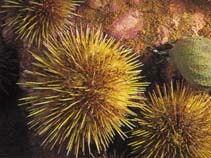Strongylocentrotus droebachiensis (Müller, 1776)
Northern sea urchin| Native range | All suitable habitat | Point map | Year 2050 |

|
| This map was computer-generated and has not yet been reviewed. |
| Strongylocentrotus droebachiensis AquaMaps Data sources: GBIF OBIS |
Классификация / Names народные названия | синонимы | CoL | ITIS | WoRMS
Echinoidea | Camarodonta | Strongylocentrotidae
Environment: milieu / climate zone / пределы глубины / distribution range экология
; пределы глубины 0 - 300 m (ссылка 78719), usually 0 - 50 m (ссылка 113749). Temperate; 79°N - 37°N, 127°E - 97°E
Distribution страны | регионы FAO | Ecosystems | места находок | интродукции
Northern Pacific, Northern Atlantic and the Arctic. Temperate to polar.
Length at first maturity / Size / Weight / Возраст
половая зрелость: Lm 2.5 range ? - ? cm Max length : 10.0 cm WD самец/пол неопределен; (ссылка 865); наибольший возраст (опубликованны данные): 45 годы (ссылка 90469)
Life cycle and mating behavior половая зрелость | размножение | нерест | Eggs | Fecundity | Larvae
Основная ссылка
ссылки | координатор | соавторы
Berkes, F., T.P. Hughes, R.S. Steneck, J.A. Wilson, D.R. Bellwood, B. Crona, C. Folke, L.H. Gunderson, H.M. Leslie, J. Norberg, M. Nyström, P. Olsson, H. Österblom, M. Scheffer and B. Worm 2006 Globalization, roving bandits, and marine resources. Science. 311:1557-1558. (ссылка 861)
Статус Красного Списка МСОП
(ссылка 130435: Version 2025-1)
Статус СИТЕС (ссылка 108899)
CMS (ссылка 116361)
Угроза для людей
Использование человеком
рыболовство: коммерческий
| FishSource | Sea Around Us
инструменты
дополнительная информация
ресурсы в Интернет
BHL | BOLD Systems | CISTI | DiscoverLife | FAO(Publication : search) | Fishipedia | GenBank (Геном, Нуклеотид) | GloBI | Gomexsi | Google Books | Google Scholar | Google | PubMed | Tree of Life | Wikipedia (Вперёд, поиск) | Zoological Record



